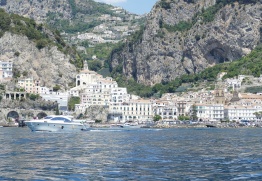Arechi Castle

Based on texts by Strabo and Livy, De Angelis traced the castle back to the classical age and M.Fiore proposed the same date asserting that in the third century. Rome fortified Salerno, already its colony, with a castle-Castrum-erected on top of Mount Bonadies "good morning", so-called because - being the highest part of the city - at dawn the sun rising from the east, first illuminated the vertex.
The medieval castle of Salerno encompasses three centuries of Lombard civilization (from the eighth to the eleventh century). The results of the archaeological investigations in the perimeter of the Turris major have revealed that the oldest construction phase dates back to the Gothic-Byzantine period.
Arechi II, a Lombard prince who moved the capital of the duchy from Benevento to Salerno, chose the already existing fortress as the centerpiece of his new capital, located 300 meters above sea level on the top of Mount Bonadies. Arechi raised it and modified the ancient walls on pre-existing fortifications and built a castle "by nature and by impregnable art, since in Italy it was not a fortress more equipped with it". In fact, on the Salerno hill there had been, already in previous centuries, a generic frequentation dating back to Roman times and evidenced by several archaeological finds and ceramic fragments. For Arechi II, therefore, it was only necessary to strengthen the manor, and to insert it in a more complex urban defense system.
To the north-west stands the watchtower called the "Bastille" to highlight the validity of the defense system. In the most eminent part there are a series of towers arranged around the central body and connected by crenellated walls and drawbridges. In later periods extensions were added to increase the efficiency and functionality of the services.
The progress of this fortification could also allow a reduced number of defenders to assume a dominant position during the retreat towards the pigeonholed summit, in case the opponents had penetrated inside the urban enclosure.
This is an example of the Middle-Byzantine defense mechanism, normally used for cities located at the foot of a hill. In 1077 the "Castello di Arechi" was stolen from Gisulfo II, the last Lombard prince of Salerno to become a Norman stronghold, functional for the penetration of the Nordic knights into the southern lands.
Beniamino da Tutela (the Navarrese Jew Benjamin bar Jonah), in his Sefer Massa'ot or Book of Travels, recalls how, in the XII century, Salerno was "surrounded by walls in the part facing the earth, while the other part is on the shores of the sea; at the top of the hill there is a well-equipped castle ".
Later, the "Castello di Arechi" became an important element in the Aragonese defensive chessboard, only to gradually lose its importance with the changing of the war techniques. It was almost completely abandoned in the 19th century.































